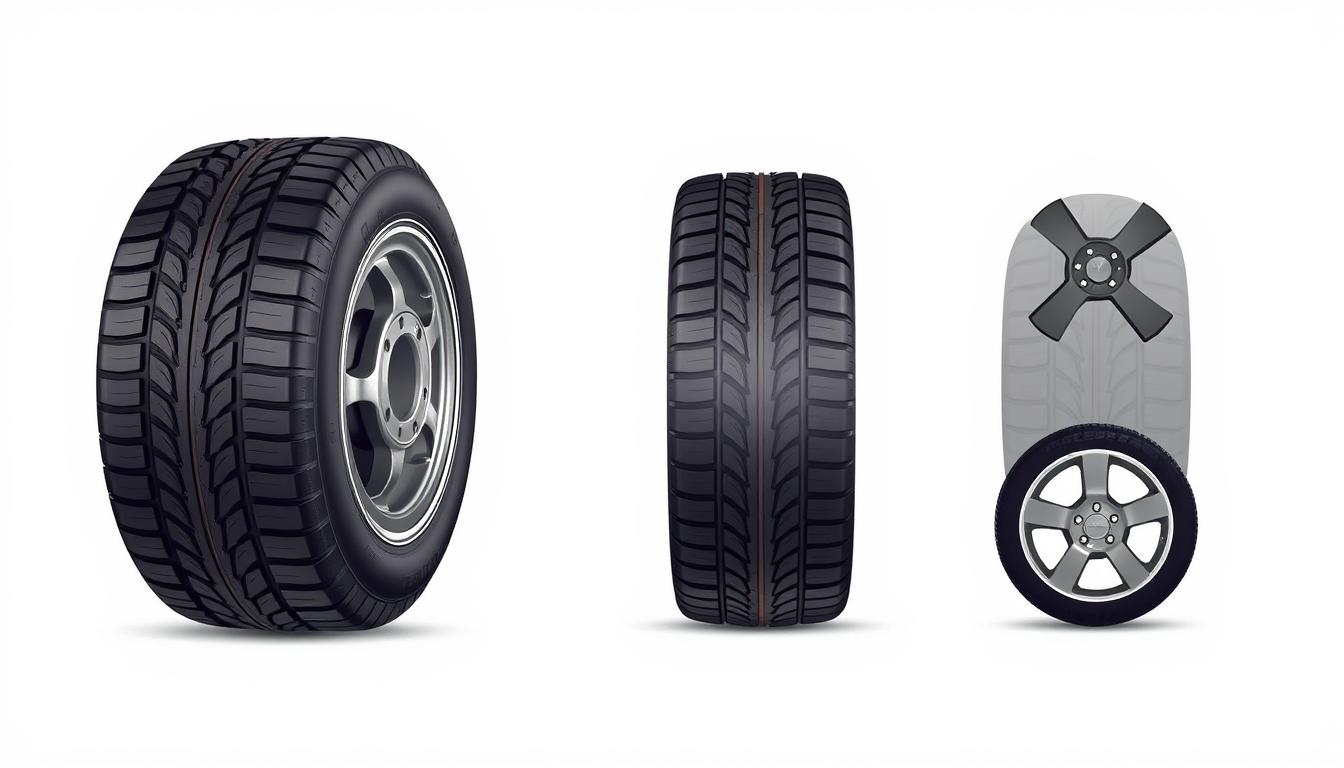Ever noticed how the treads on your car’s wheels wear differently? That’s where proper Toyota tire maintenance comes into play. Moving each wheel to a different position helps distribute wear evenly. This extends the lifespan of your rubber companions on the road.
Your vehicle’s drivetrain configuration determines the ideal rotation pattern. Front-wheel drive Camrys need a different approach than all-wheel drive RAV4s or rear-wheel drive Tacomas. Using the right pattern ensures balanced performance and maximum tread life.
Regular rotation offers multiple benefits beyond just saving money on replacements. It improves handling, increases fuel efficiency, and enhances overall safety during various driving conditions. Most experts recommend this service every 5,000 to 7,500 miles.
In this guide, we’ll explore the specific rotation patterns recommended for different models. We’ll also cover the tools you’ll need for a DIY approach and professional tips. Whether you’re a seasoned mechanic or a first-time car owner, understanding these fundamentals will help keep your vehicle running smoothly for years to come.
The Importance of Tire Rotation for Toyota Vehicles
Tire rotation greatly affects how your Toyota handles and brakes. It’s a key part of Toyota tire care that keeps your car running well. Tires wear out slowly, so regular rotation is a must.
Toyota cars wear tires differently, depending on how they’re driven. The front tires wear faster because they carry the engine’s power. Without rotation, your tires will wear unevenly, affecting your car’s safety and performance.
Not rotating your tires can void the warranty. Manufacturers know how important it is for tire health. Following their rotation schedules is crucial for your car’s performance and your safety.
How Tire Rotation Affects Vehicle Performance
Uneven tire wear hurts your Toyota’s performance. It makes your car pull to one side when braking. You might also need to steer more to stay straight.
Rotation keeps your tires balanced, which is key for safety features. Features like traction control work better with evenly worn tires. This balance is vital for your safety on the road.
Skipping rotation is risky, especially in bad weather. Uneven tires hydroplane more easily. In emergencies, your car’s response depends on balanced tires, which rotation provides.
Impact on Tire Longevity and Safety
Following Toyota’s rotation schedule saves you money. Even wear can add 5,000-10,000 miles to your tires’ life. This means big savings over time.
- Properly rotated tires last 20-30% longer
- Even wear improves fuel efficiency
- Regular rotation spots alignment issues early
Proper tire rotation is about safety, too. Uneven wear increases the risk of blowouts, especially in hot weather. Tires with even tread stop better in emergencies.
Toyota’s engineers design rotation patterns for each model. These patterns consider the car’s weight, drivetrain, and handling. Following these ensures your car stays safe and performs as intended.
Toyota Tire Rotation Patterns Explained
Toyota vehicles use three main tire rotation patterns. Each is for different drivetrain types and driving conditions. The correct rotation pattern ensures even tire wear and maximizes tread life. It also keeps your vehicle handling well.

The pattern you choose depends on your Toyota’s drivetrain. Front-wheel drive cars like the Corolla and Camry have different wear patterns than rear-wheel drive models like the Tacoma. All-wheel drive vehicles, such as the RAV4, also have their own patterns.
Forward Cross Pattern
The Forward Cross Pattern is best for front-wheel drive Toyotas. This includes many sedans and compact cars. In this pattern, the front tires move straight to the rear while staying on the same side.
The rear tires move to the front but switch sides. The rear-right tire goes to the front-left, and the rear-left goes to the front-right. This creates a forward-facing “X” with the rear tires only.
This pattern is great for front-wheel drive Toyotas. It addresses the accelerated wear on the front tires. By rotating the less-worn rear tires to the front and crossing them, you ensure even tread wear. The Forward Cross Pattern helps compensate for the turning forces that affect front tires differently than rear tires.
X-Pattern
The X-Pattern is an alternative for front-wheel drive Toyota vehicles. Unlike the Forward Cross, this pattern creates a complete “X” by moving all tires diagonally to opposite corners of the vehicle.
In this configuration, the front-right tire moves to the rear-left position, and the front-left tire moves to the rear-right position. Similarly, the rear-right tire moves to the front-left position, and the rear-left tire moves to the front-right position.
The X-Pattern provides extremely uniform wear across all four tires. It’s especially beneficial for vehicles that experience varied driving conditions. Many Toyota owners alternate between the Forward Cross and X-Pattern with each rotation service to achieve the most balanced tire wear possible. This pattern helps equalize wear patterns that develop from turning forces and weight distribution.
Rearward Cross Pattern
The Rearward Cross Pattern is the reverse of the Forward Cross. It’s recommended for rear-wheel drive and all-wheel drive Toyota models. This includes popular vehicles like the Tacoma, Tundra, 4Runner, and certain RAV4 configurations.
In this pattern, the rear tires move straight forward to the front axle while staying on the same side. The front tires move to the rear but switch sides—the front-right tire moves to the rear-left position, and the front-left tire moves to the rear-right position.
This pattern addresses the unique wear characteristics of rear-wheel and all-wheel drive vehicles. It helps compensate for the increased wear on drive wheels while ensuring all tires wear evenly over time.
For Toyota’s AWD vehicles with full-time four-wheel drive systems, this pattern helps distribute wear more evenly across all four tires. Following this pattern consistently maintains balanced traction and handling characteristics. These are essential for these vehicles’ performance and safety.
Identifying the Right Rotation Pattern for Your Toyota
Your Toyota’s drivetrain type is key to finding the best tire rotation pattern. Different drivetrain setups lead to unique tire wear patterns. Knowing your vehicle’s mechanical setup helps you use the best tire rotation practices for your Toyota.
Toyota vehicles have three main drivetrain types: front-wheel drive (FWD), rear-wheel drive (RWD), and all-wheel drive (AWD). Each type affects how power is distributed, leading to different wear patterns. Let’s look at the right rotation patterns for each drivetrain type.
Front-Wheel Drive Toyota Models
Front-wheel drive Toyotas, like the Camry and Corolla, wear out their front tires faster. This is because the front wheels handle steering and power, leading to more friction. The engine’s weight also adds pressure to these tires.
For FWD Toyotas, the Forward Cross or X-Pattern rotation is best. This pattern moves the front tires to the rear and vice versa. The Forward Cross pattern switches the front tires to opposite sides at the rear, balancing wear.
Rotating tires every 5,000-7,500 miles is key for FWD Toyotas. Their front tires wear out twice as fast as the rear. This Toyota tire maintenance schedule extends tire life and keeps handling balanced.
Rear-Wheel Drive Toyota Models
Rear-wheel drive Toyotas, like the GR86, wear out their rear tires faster. The rear tires handle acceleration, while the front manage steering. This leads to faster rear tire wear.
The Rearward Cross pattern is best for RWD Toyotas. It moves the rear tires to the front and vice versa. This helps balance wear on each axle.
RWD vehicles also benefit from rotation every 5,000-7,500 miles. But, if you drive in high-performance conditions or carry heavy loads, rotate tires more often. This keeps traction and handling optimal.
All-Wheel Drive Toyota Models
All-wheel drive Toyotas, like the RAV4, distribute power to all four wheels. This creates balanced but uneven wear patterns. Factors like weight distribution and driving habits also affect wear.
The X-Pattern rotation is often best for AWD Toyotas. It moves each tire to a different position, balancing wear. The X-Pattern switches the right front with the left rear and vice versa.
Toyota suggests rotating tires on AWD models every 5,000-7,500 miles. But, if you drive on rough terrain or in severe weather, rotate every 3,000-5,000 miles. Some AWD systems may have specific rotation recommendations.
Always check your owner’s manual for model-specific tire rotation recommendations. Following these guidelines ensures proper Toyota tire maintenance for your vehicle.
Essential Tools for Toyota Tire Rotation
Proper Toyota tire rotation needs specific tools for safety and efficiency. Whether you’re a DIY expert or a new Toyota owner, the right tools are key for Toyota tire care. Let’s look at the tools you need and some extras that make the job easier.
Basic Tools Every Toyota Owner Should Have
The right lifting equipment is the start of a good tire rotation guide. A hydraulic floor jack that matches your Toyota’s weight is crucial. It gives the stability and power needed for safe rotation. The emergency scissor jack is for quick tire changes but not stable enough for rotation.
Jack stands are a must for safety. Use ones rated for your Toyota’s weight and place them at the recommended lifting points. Never rely only on a jack to support your car while working underneath it.
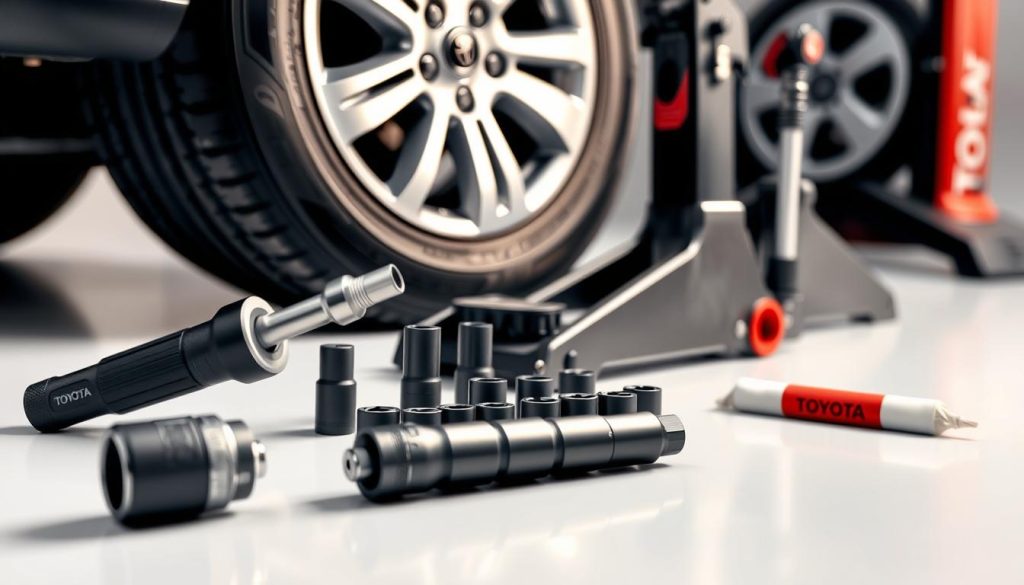
A lug wrench or socket set with the correct size for your Toyota’s lug nuts is essential. Most Toyotas use 19mm or 21mm lug nuts, but check your model. A torque wrench ensures you tighten the lug nuts correctly, avoiding over-tightening or loosening.
Optional Tools for Easier Rotation
While not necessary, some tools can make Toyota tire care easier and safer. Wheel chocks prevent the car from moving during rotation. This simple step adds a lot of safety.
Mechanic’s gloves protect your hands from sharp edges and hot parts, especially if you’re rotating tires after driving. A tire pressure gauge lets you check and adjust pressure, ensuring even wear and performance.
A rubber mallet is helpful for wheels stuck to the hub. Gentle taps can break the bond without damage. Also, apply anti-seize lubricant to the lug studs to prevent seizing and make future rotations easier.
Lastly, consider getting a Toyota service manual or using Toyota’s online technical info. These resources give you the exact torque specs, lifting points, and rotation patterns for your model. They make following the tire rotation guide easier.
Step-by-Step Toyota Tire Rotation Guide
Rotating your Toyota’s tires is a DIY task that boosts your car’s performance. A proper tire rotation extends tire life, improves handling, and saves fuel. This guide will help you do it right.
Preparation Steps
Start by preparing your Toyota for a safe tire rotation. Park on a flat, level surface, like concrete. Make sure your parking brake is on and use wheel chocks.
Get your tools ready: a lug wrench, torque wrench, jack, and jack stands. Check your owner’s manual for the right rotation pattern for your Toyota.
Loosen the lug nuts on all wheels before lifting. This makes it easier than when the tire is up. Use counterclockwise force, and you might need to stand on the wrench.
Safely Lifting Your Toyota
Lifting your vehicle safely is key. Find the right jacking points in your Toyota owner’s manual. Wrong points can damage your car.
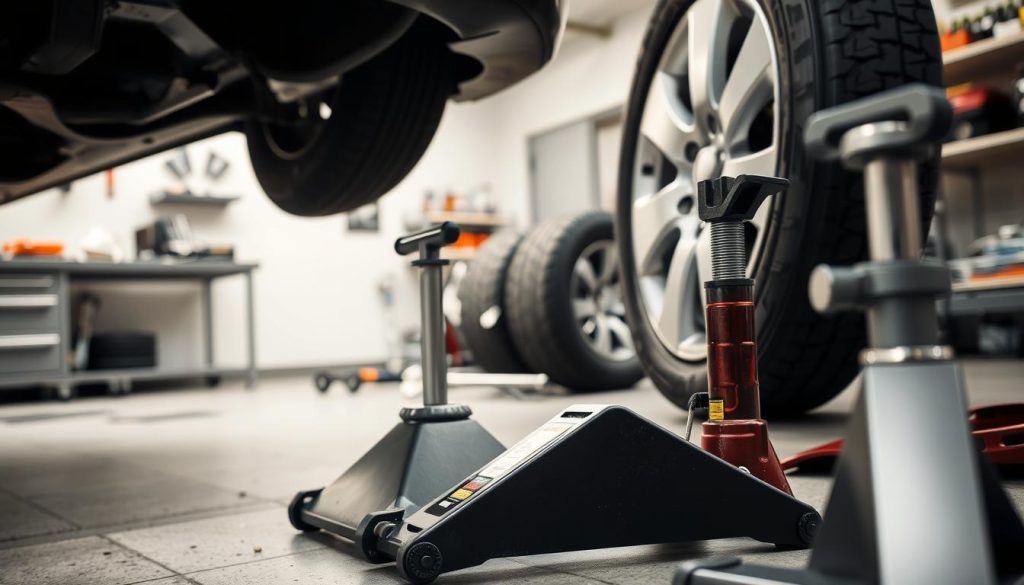
Put your jack under the first tire’s jacking point. Raise it slowly until the tire is 6 inches off the ground. Lift carefully to avoid weight shifts.
Using Jack Stands Properly
Once raised, use jack stands for support. Place them under Toyota’s recommended points. Lower the jack until the vehicle rests on the stands.
Use jack stands in pairs on the same side. Never use cinder blocks or wood instead, as they can break.
Safety Precautions
Always prioritize safety during tire rotation. Never stand under a vehicle on a hydraulic jack. Jacks can fail suddenly.
Test the vehicle’s stability after placing it on jack stands. Keep children and pets away. Wear protective eyewear and remove loose items to avoid injuries.
Executing the Rotation Pattern
With your Toyota supported, start the rotation. Remove the lug nuts and store them safely. Pull the tire straight off, being careful not to strain your back.
Choose the right pattern for your Toyota. For front-wheel drive, use the forward cross pattern. Rear-wheel drive models use the rearward cross pattern.
When moving tires, lift with your legs. Align the holes with the wheel studs. Hand-tighten the lug nuts in a star pattern before lowering.
Final Checks and Torque Specifications
After rotating, lower your Toyota to the ground. Remove the jack stands slowly. Use a torque wrench to tighten the lug nuts to Toyota’s specs.
Check the tire pressures and tread patterns. Adjust the pressures to the driver’s door jamb sticker specs. After driving, recheck the lug nut torque.
This tire rotation guide keeps your Toyota running well and extends tire life.
Recommended Tire Rotation Frequency for Toyota Vehicles
Knowing when to rotate your Toyota’s tires is key to their longevity and your driving pleasure. Regular rotation ensures even wear, boosting performance and delaying replacements. Let’s look at Toyota’s guidelines and how your driving habits might change your rotation schedule.
Standard Recommendations from Toyota
Toyota suggests rotating tires every 5,000 to 6,000 miles or every six months, whichever comes first. This standard tire rotation frequency matches Toyota’s oil change schedule, making maintenance easier.
Following this schedule is vital. It spreads wear evenly, potentially adding 20% to your tires’ life. It also keeps your car handling well, especially in emergencies or bad weather.
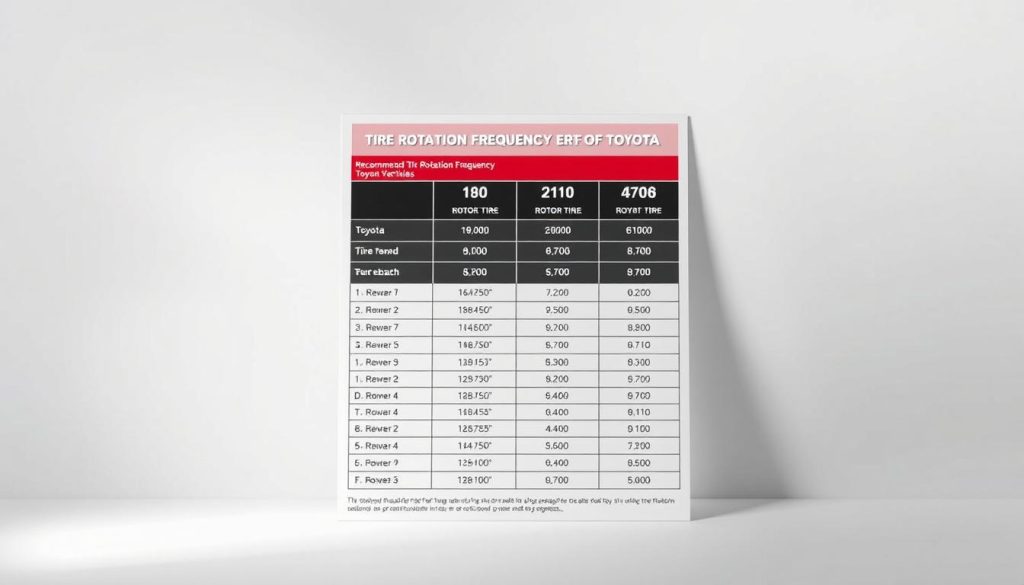
Toyota’s manuals warn that skipping a rotation can cause uneven wear. Most dealerships keep track of your rotation history, helping you follow the manufacturer’s advice.
Adjusting Frequency Based on Driving Conditions
While Toyota offers general guidelines, your driving habits and conditions might need a different rotation schedule. Different environments can lead to unique wear patterns, sometimes requiring more frequent rotations.
City vs. Highway Driving Considerations
City driving, with its stops, starts, and turns, wears tires faster, especially the front tires of front-wheel-drive Toyotas. If you mostly drive in the city, consider rotating your tires every 4,000 miles instead of the usual 5,000-6,000 miles.
Highway driving, though easier on tires, also has its wear patterns. Drivers who mostly drive on highways might stick to the standard rotation schedule. However, they should check tire pressure more often due to temperature changes at high speeds.
Off-Road and Severe Conditions
Toyota owners who drive off-road or in severe conditions should rotate their tires more often. These conditions include:
- Unpaved or gravel roads
- Mountainous terrain
- Extreme hot or cold temperatures
- Heavy loads or towing
In these cases, Toyota advises rotating tires every 3,000-4,000 miles. This helps maintain balanced performance in tough conditions.
| Driving Condition | Recommended Rotation Frequency | Warning Signs | Additional Maintenance |
|---|---|---|---|
| Normal/Mixed Driving | 5,000-6,000 miles | Slight outer edge wear | Regular pressure checks |
| City/Urban Driving | 4,000-5,000 miles | Front tire shoulder wear | Alignment checks |
| Highway Driving | 5,000-6,000 miles | Center tread wear | Frequent pressure adjustments |
| Off-Road/Severe | 3,000-4,000 miles | Irregular wear patterns | Inspection for damage |
Signs Your Toyota Tires Need Rotation
Your Toyota might show signs it needs tire rotation before the recommended time. Keeping an eye out for these signs is key to avoiding early wear and keeping your car running well. Regular rotation can make your tires last longer and improve your drive. Let’s look at the signs that tell you it’s time for a rotation.
Visual Indicators of Uneven Wear
Checking your tires visually is the best way to know if they need rotation. Make it a habit to look at your tires often as part of your care routine.Uneven tread depthis a clear sign. Front tires on Toyotas with front-wheel drive wear faster on the outside. Rear tires usually wear more evenly.
Use a tread depth gauge to check different spots on each tire. If the depth varies by more than 2/32 of an inch, it’s time for rotation.
Look for “feathering” or “scalloping” patterns where the tread blocks are worn more on one side. You can feel this by running your hand over the tire.

Excessive wear in the center of the tread or on both outer edges is another sign. These issues need proper inflation and rotation to even out wear.
Performance Indicators That Signal Rotation Needs
Your Toyota will also tell you when it needs tire rotation through changes in how it drives. Pay attention to these signs on your daily drive.Vibration in the steering wheelat certain speeds often means uneven wear. This imbalance can start small but gets worse if not fixed.
If your Toyota pulls to one side while driving or braking, it might need rotation. You might also notice it’s harder to stop on wet roads because worn tires can’t channel water well.
Increased road noise is another sign. Uneven wear makes tires noisier, making your car louder.
| Visual Indicators | Performance Indicators | Severity Level |
|---|---|---|
| Uneven tread depth | Steering wheel vibration | Moderate |
| Feathering/scalloping | Vehicle pulling to one side | High |
| Center/edge wear | Decreased wet traction | Moderate to High |
| Visible tread differences | Increased road noise | Low to Moderate |
These symptoms might also mean alignment or balance problems. But rotation is often the first step to fix these issues if caught early. Regular rotation can prevent many problems from happening in the first place.
Benefits of Following Proper Toyota Tire Rotation Schedules
Keeping up with Toyota’s tire rotation schedules brings big wins in performance, safety, and saving money. By following Toyota’s tire rotation recommendations, you’re not just doing maintenance. You’re also making your car last longer and driving better. Regular rotation spreads wear evenly across all tires, boosting your car’s performance and saving your wallet.
Extended Tire Life
Following best tire rotation practices can make your tires last up to 20% longer. This means you won’t need to replace them as often. A good set of tires for your Toyota can cost $600-$1,200. So, making them last longer saves you a lot of money.
Spending $20-$50 for a professional rotation every 5,000-7,500 miles can save you hundreds. This is because rotation spreads wear evenly, stopping tires from wearing down too fast.
Front tires wear out faster on Toyotas because of steering and acceleration. Regular rotation balances wear, making your tires last longer.
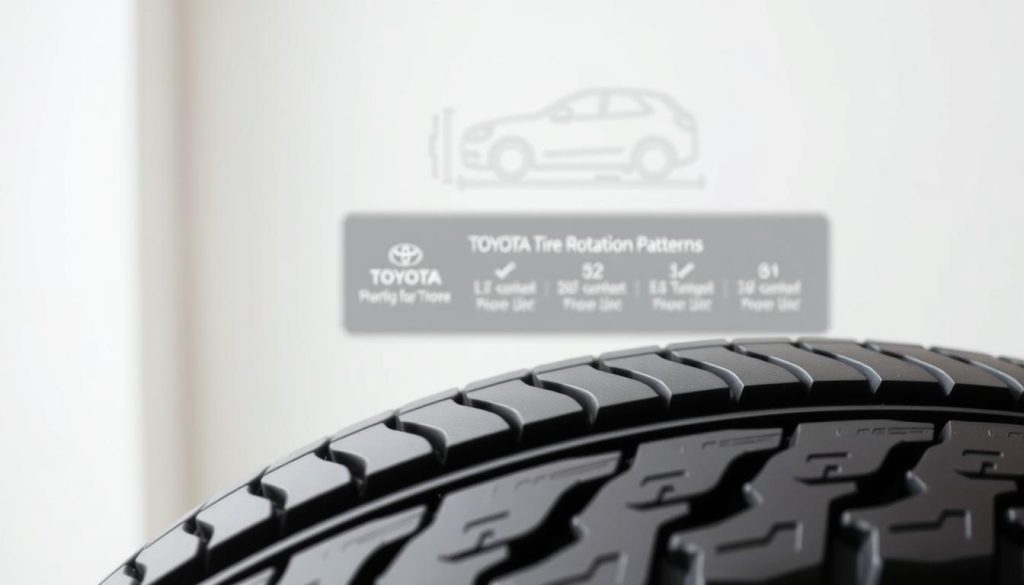
Improved Fuel Efficiency
Evenly worn tires make your Toyota use less fuel. Uneven wear creates drag, making your engine work harder and use more fuel. Toyota says proper tires can improve fuel economy by up to 3%.
This small improvement can add up. For a Toyota Camry, it could save nearly half a gallon per fill-up. Over a year, this could save you $50-$150, depending on your driving and fuel prices.
Also, regular rotation often means checking tire pressure, which is key for fuel efficiency. Underinflated tires can cut fuel economy by about 0.2% for every 1 PSI drop.
Enhanced Vehicle Handling and Safety
The safety benefits of proper tire rotation patterns are huge. Evenly worn tires give better traction and handling, especially in emergencies and bad weather. This is crucial for staying in control when it matters most.
Toyota’s safety systems like ABS and VSC need consistent tire performance to work right. Uneven wear can make these systems less effective, risking your safety.
Properly rotated tires also lower the chance of blowouts and failures that can cause accidents. Even wear means better grip on wet or slippery roads, cutting stopping distances and improving control. This makes regular tire rotation key for your safety and your passengers’.
Common Mistakes to Avoid When Rotating Toyota Tires
Rotating your Toyota’s tires correctly is key. But, it can’t fix all problems. Issues like worn parts, wrong inflation, or alignment problems need separate fixes. Knowing these mistakes helps you use proper tire rotation techniques and make your tires last longer.
Incorrect Pattern Selection
Many Toyota owners make a big mistake. They use the wrong rotation pattern for their car. Front-wheel drive Toyotas need different patterns than rear-wheel or all-wheel drive models. Using the wrong pattern can make your tires wear out faster.
For example, using an X-pattern on a front-wheel drive RAV4 can cause uneven wear. This happens when owners follow general advice instead of Toyota’s specific recommendations for their model.
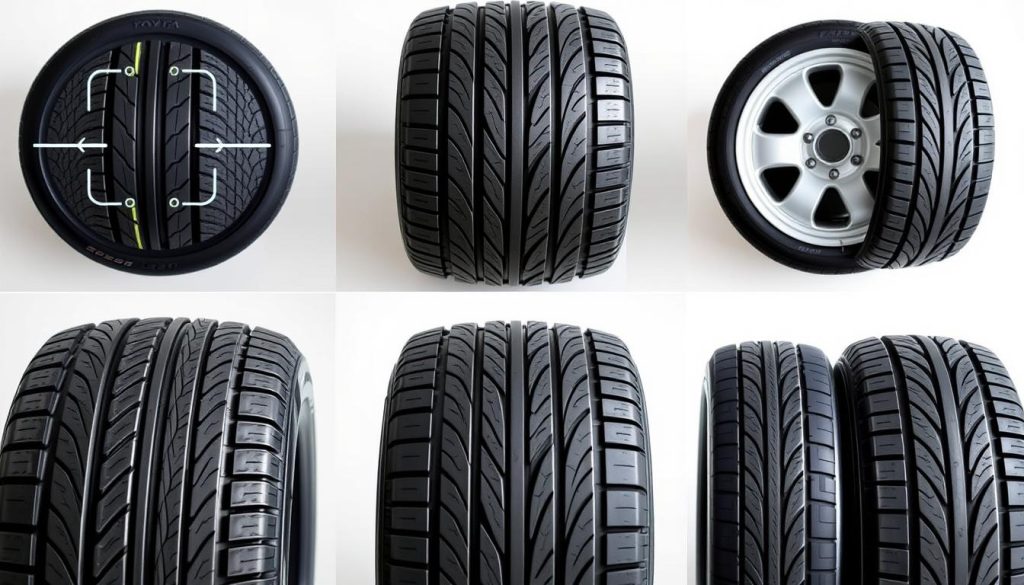
When the tread on your front and rear tires is different, put the tires with more tread on the rear axle. This makes your car more stable and less likely to hydroplane, no matter the drivetrain.
Improper Torque Application
Another big mistake is using the wrong torque when putting wheels back on. If you don’t tighten enough, the wheels can come loose while driving. But, tightening too much can damage brake rotors, strip threads, or break wheel studs.
Toyota gives exact torque values for each model. Most passenger Toyotas need 76-89 ft-lbs of torque. Trucks and SUVs like the Tundra and Sequoia need 83-97 ft-lbs. Always use a torque wrench and tighten in a star or cross pattern to ensure even pressure.
Following best tire rotation practices means tightening in stages. This prevents warping and ensures the wheel seats properly.
Neglecting Tire Pressure Checks
Many Toyota owners rotate their tires without checking the pressure. This is a missed chance for full tire maintenance. It’s a good time to check that all tires, including the spare, are at the right PSI levels.
Temperature changes affect tire pressure a lot. A 10°F drop can lower pressure by about 1 PSI. Even if you rotate your tires right, uneven wear can still happen if they’re not at the right pressure.
The recommended pressure for most Toyota passenger vehicles is 32-35 PSI. Trucks and SUVs may need 35-44 PSI. These numbers are on the driver’s door jamb sticker, not the tire sidewall.
| Common Mistake | Consequence | Prevention Method |
|---|---|---|
| Wrong rotation pattern | Accelerated uneven wear | Follow Toyota’s model-specific pattern recommendations |
| Incorrect torque | Loose wheels or damaged components | Use a torque wrench set to Toyota specifications |
| Skipping pressure checks | Uneven wear despite rotation | Check and adjust pressure during every rotation |
| Mixing rotation with alignment issues | Continued irregular wear patterns | Address alignment problems before rotation |
By avoiding these common mistakes, you’ll get the most out of your tire rotation. Remember, proper tire rotation is part of a bigger tire maintenance plan for your Toyota.
Professional vs. DIY Toyota Tire Rotation
Choosing between DIY and professional service for Toyota tire rotation depends on several factors. Regular tire rotation is key for Toyota tire maintenance. It helps extend tire life and keeps your vehicle running well. But, deciding whether to do it yourself or get a professional’s help isn’t easy. Your mechanical skills, tools, and vehicle needs are all important.
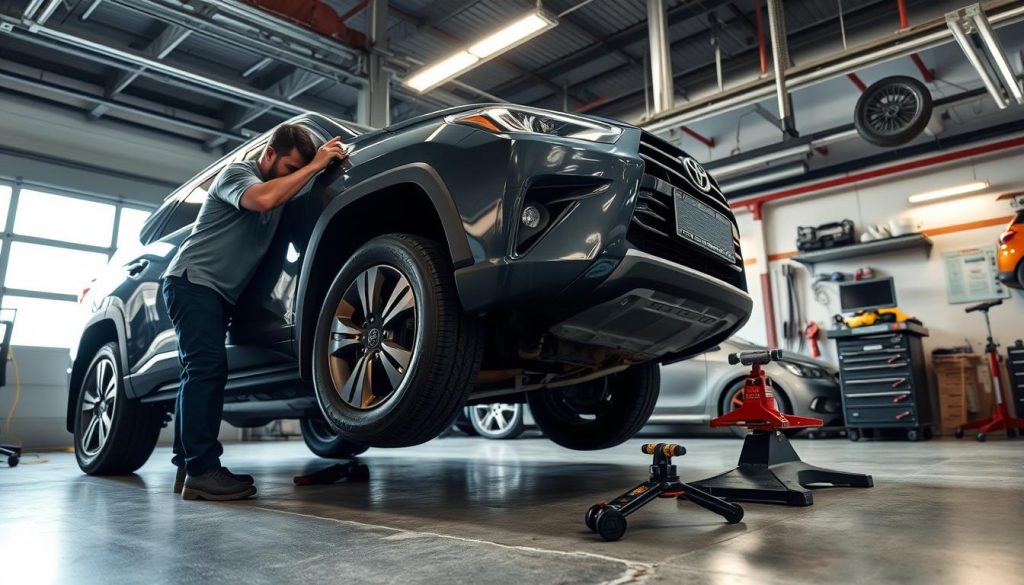
When to Do It Yourself
Rotating your tires yourself can be rewarding and save money. If you like working on your car and know a bit about mechanics, doing it at home might be best for you.
It’s a good idea to rotate your tires yourself if you have:
- Proper tools and equipment – like a reliable jack, jack stands, lug wrench, and a torque wrench for tightening
- Adequate workspace – a flat, level area with enough room to safely move around your car
- Physical capability – the strength and mobility to handle heavy wheels and tires
- Sufficient time – about 45 minutes to an hour without rushing
DIY tire rotation lets you check your tires closely. You can spot unusual wear or damage that might be missed. It also helps you learn valuable mechanical skills. Many Toyota owners enjoy maintaining their cars personally, following the tire rotation guide for proper care.
When to Seek Professional Service
While DIY works for many, there are times when professional service is better. Professional technicians have the knowledge and tools to make the process safer and more efficient.
Consider professional service when:
- You lack proper equipment – especially a torque wrench, which is crucial for securing wheels
- Your Toyota has special considerations – like TPMS that needs recalibration after rotation
- You own larger Toyota models – such as Tundra or Sequoia, with heavier wheels
- You want comprehensive service – including rotation with tire balancing, alignment checks, or other maintenance
Toyota dealership service centers and certified mechanics have the specialized knowledge for your model. They keep computerized service records that track your rotation history. They can also recommend the best pattern for your driving habits.
Professional technicians can spot issues that might not be obvious. Many Toyota owners find the cost of professional rotation is worth it. It saves time and gives peace of mind, especially when combined with other routine maintenance services.
Cost Considerations for Toyota Tire Rotation
Toyota owners often think about whether DIY tire rotation is worth it. They compare the cost of doing it themselves to getting it done by a professional. Knowing the upfront costs and long-term benefits is key to making a good choice. Regular Toyota tire care is important, but the cost can vary a lot.
DIY Cost Breakdown
DIY tire rotation needs some initial tool investments. A good floor jack costs $70-150, and jack stands are $30-60. You’ll also need a torque wrench ($40-100) and a socket set ($30-80) for the lug nuts.
These tools are a one-time cost that pays off after 3-4 rotations. They can also be used for other car maintenance tasks like brake pad replacement or oil changes.
Time is another factor for DIY fans. Beginners might spend 30-60 minutes, while experts can do it in 15-30 minutes. This time should be considered, especially if you plan to rotate your tires regularly.
Professional Service Pricing
Professional tire rotation costs vary. Toyota dealerships charge $20-40, but it’s free with oil changes or Toyota Care for newer cars.
Independent mechanics charge $15-30, and tire shops offer the cheapest option at $10-25. Many tire shops include free lifetime rotations with tire purchases.
Several things affect the cost. Larger vehicles like the Tundra cost more than smaller ones like the Yaris. Premium wheels and vehicles with Tire Pressure Monitoring Systems (TPMS) may also cost extra.
| Service Provider | Cost Range | Additional Benefits | Best For |
|---|---|---|---|
| Toyota Dealership | $20-40 | Factory-trained technicians, often free with Toyota Care | Newer Toyota models under warranty |
| Independent Mechanic | $15-30 | Personalized service, potential package deals | Older Toyota models, established customer relationships |
| Tire Shop | $10-25 | Free with tire purchase, tire expertise | Budget-conscious owners, recent tire buyers |
| DIY | $170-390 initial investment | Long-term savings, skill development | Hands-on owners, multiple Toyota vehicles |
For those who value convenience, many service centers offer maintenance packages. These include regular tire rotations and other services. They can be a better deal than paying for each service separately and ensure your tires are rotated as recommended.
Model-Specific Toyota Tire Rotation Guidelines
Knowing the right tire rotation for your Toyota can make your tires last longer and drive better. While most cars need a tire rotation every six months or 6,000 miles, the best pattern varies by model. Let’s look at what’s best for different Toyotas.
Toyota Sedans: Camry, Corolla, and Avalon
Toyota sedans, like the Camry and Corolla, have front-wheel drive. This means the front tires wear out faster. The forward cross pattern is best for these cars, moving the front tires to the back and vice versa.
The Avalon, being heavier, might wear out faster. Sporty versions, like the Camry TRD, need a rotation every 5,000 miles. Newer AWD sedans do better with the X-pattern, spreading wear evenly.
Toyota SUVs: RAV4, Highlander, and 4Runner
Toyota SUVs need extra care because of their high center of gravity and different drivetrains. The RAV4 and Highlander, being crossovers, usually follow the forward cross pattern for FWD and X-pattern for AWD.
The 4Runner, being a truck-based 4WD, does best with the rearward cross pattern. SUV owners who go off-road should rotate tires more often. Regularly check tire pressure, as it’s key for these heavier vehicles.
Toyota Trucks: Tacoma, Tundra, and Sequoia
Toyota trucks face special challenges due to their heavy loads and off-road use. The Tacoma and Tundra do well with the rearward cross pattern, helping even out wear.
Trucks with different tire sizes front and rear should rotate side-to-side only. Those used for towing often need a rotation every 5,000 miles. The Sequoia, despite being an SUV, follows truck rotation rules because of its platform.
Toyota Hybrid and Electric Vehicles
Toyota’s hybrids and electric cars have unique wear patterns due to their special weight and braking systems. The Prius family and RAV4 Hybrid wear out front tires faster because of the battery weight.
For these models, the forward cross pattern is best, with a rotation every 5,000 miles suggested. The bZ4X electric SUV benefits from the X-pattern. Hybrid owners should watch tire pressure closely, as it affects fuel efficiency.
| Toyota Model Type | Recommended Pattern | Rotation Interval | Special Considerations |
|---|---|---|---|
| FWD Sedans | Forward Cross | 6,000 miles | More frequent for sport trims |
| AWD/4WD SUVs | X-Pattern | 5,000-6,000 miles | More frequent for off-road use |
| Trucks | Rearward Cross | 5,000 miles | Side-to-side for different sized tires |
| Hybrids/Electric | Forward Cross/X-Pattern | 5,000 miles | Monitor pressure for efficiency |
Integrating Tire Rotation with Toyota’s Maintenance Schedule
Keeping up with a Toyota maintenance plan that includes regular tire rotations is key. It boosts your vehicle’s performance and life span. By aligning tire rotations with other routine services, your Toyota gets consistent care without many trips to the service center. This approach saves time and helps keep track of your vehicle’s health on a set schedule.
Combining with Oil Changes and Regular Service
One smart way to keep your Toyota’s tires in top shape is to schedule rotations with oil changes. Most Toyotas need oil changes every 5,000 to 10,000 miles, depending on the model and oil type. This makes it easy to rotate your tires at the same time.
This method has many benefits. It creates a simple maintenance rhythm that’s easy to follow. When it’s time for an oil change, it’s also time to rotate your tires. It also cuts down on service visits, saving you time all year. Plus, it keeps your tires in good shape before wear becomes a problem.
A typical maintenance timeline might look like this:
- 5,000 miles: Oil change + tire rotation + multi-point inspection
- 10,000 miles: Oil change + tire rotation + brake inspection
- 15,000 miles: Oil change + tire rotation + cabin air filter replacement
- 20,000 miles: Oil change + tire rotation + comprehensive vehicle inspection
While this schedule works for many, always check your specific model’s owner manual. It will tell you the tire rotation frequency and pattern your vehicle needs. Some high-performance models or vehicles with staggered tires might have different needs.
Toyota Care and Extended Maintenance Plans
New Toyotas usually come with Toyota Care, a free maintenance plan. It covers scheduled service for the first 2 years or 25,000 miles, whichever comes first. This plan includes regular tire rotations, making it easy to care for your tires from the start.
Toyota Care includes:
- Tire rotations at recommended intervals
- Oil and filter changes
- Multi-point inspections
- Fluid level adjustments
For more coverage, Toyota offers extended maintenance plans. These plans keep your vehicle in top shape beyond the initial period. They’re great for keeping up with Toyota tire maintenance throughout your ownership.
Getting your tire rotations done at Toyota dealerships has extra benefits. It creates a detailed service history in Toyota’s system. This record is valuable when selling your vehicle or returning a lease, showing you’ve taken good care of it.
For lease customers, these plans are especially helpful. Leased vehicles must be returned in good condition with proof of proper care. Toyota’s maintenance records provide clear proof, helping avoid penalties for tire wear at the end of the lease.
Whether you go with Toyota’s plans or handle service yourself, the key is to be consistent. A regular schedule that includes tire rotations with other maintenance ensures your Toyota stays in top shape.
Conclusion: Maximizing Your Toyota’s Performance Through Proper Tire Care
Regular tire rotation is a simple yet powerful way to protect your Toyota. By following the right tire care practices, you’ll make your tires last longer. This will also improve your car’s overall performance.
Each Toyota model has its own tire rotation needs. For example, front-wheel drive Corollas need the forward cross pattern. On the other hand, rear-wheel drive Tacomas do best with the rearward cross pattern. All-wheel drive models like the RAV4 are best rotated using the X-pattern.
Following Toyota’s recommended rotation schedule of 5,000-7,500 miles has many benefits. Your tires will wear evenly, giving you better traction and handling. Plus, you’ll save money by extending your tire’s life and improving fuel efficiency.
Don’t forget about the warranty benefits. Many tire warranties require proof of regular rotation. Keeping records of your rotation schedule helps protect this valuable coverage.
Whether you do it yourself or get professional help at your Toyota dealership, consistency is key. Best tire rotation practices are straightforward but require dedication.
Your Toyota deserves the best care from the ground up. With these rotation patterns and maintenance habits, you’re ready to keep your vehicle running smoothly, safely, and efficiently for many miles ahead.
FAQ
How often should I rotate the tires on my Toyota?
Toyota suggests rotating your tires every 5,000-6,000 miles or six months, whichever comes first. This matches your oil change schedule, making it easy to do both at once. If you drive in harsh conditions, like off-road or extreme weather, rotate your tires every 3,000-4,000 miles.
What tire rotation pattern should I use for my Toyota Camry?
For a Toyota Camry, use the Forward Cross Pattern or X-Pattern. This pattern moves the rear tires to the opposite front sides and the front tires straight back. It helps wear all four tires evenly, especially the front tires in front-wheel drive vehicles.
What’s the difference between the Forward Cross and Rearward Cross rotation patterns?
The Forward Cross pattern moves rear tires to the opposite front sides and front tires straight back. The Rearward Cross pattern does the opposite. These patterns are chosen based on the vehicle’s drivetrain type to address specific wear issues.
Do I need special tools to rotate my Toyota’s tires?
Yes, you’ll need basic tools for safe rotation. These include a floor jack, jack stands, a lug wrench or socket set, and a torque wrench. Optional tools include wheel chocks, gloves, anti-seize lubricant, a rubber mallet, and a tire pressure gauge.
What are the signs that my Toyota needs a tire rotation?
Look for uneven tread wear, differences in tread depth, or “feathering” patterns. Also, watch for steering wheel vibration, pulling to one side, decreased traction, or increased road noise.
What’s the correct torque specification for my Toyota’s lug nuts?
Torque specs vary by model. Most Toyota passenger cars need 76-87 ft-lbs, while trucks and SUVs may need 83-110 ft-lbs. Always check your owner’s manual for the exact spec for your Toyota. Incorrect torque can damage your vehicle.
Can I rotate my Toyota’s tires if they’re different sizes front and rear?
If your Toyota has different-sized tires, standard rotation patterns won’t work. You can only rotate tires from left to right on the same axle. Check your owner’s manual for specific guidance.
Does Toyota Care cover tire rotations?
Yes, Toyota Care covers tire rotations for 2 years or 25,000 miles, whichever comes first. This service is done during regular maintenance visits. Extended plans may offer more coverage. Check with your Toyota dealership for details.
How much does a professional tire rotation cost for a Toyota?
Costs vary by location and service provider. At Toyota dealerships, a standalone rotation costs -40, often free with oil changes. Independent mechanics charge -30, while tire shops charge -25. Larger models like the Tundra may cost more than compact models like the Corolla.
Will rotating my tires improve my Toyota’s fuel efficiency?
Yes, regular rotations can improve fuel efficiency. Evenly worn tires reduce rolling resistance, saving fuel. Uneven wear forces your engine to work harder, using more fuel. Savings add up over miles, improving your Toyota’s efficiency.
What rotation pattern should I use for my Toyota RAV4 with AWD?
For an all-wheel drive Toyota RAV4, use the Rearward Cross pattern. This moves the front tires to opposite sides at the rear and the rear tires straight to the front. It ensures even wear across all four tires, considering AWD wear characteristics. Always check your RAV4’s owner’s manual for the manufacturer’s recommendation.
Is it OK to use the emergency jack that came with my Toyota for tire rotation?
It’s not recommended to use your Toyota’s emergency jack for complete rotation. These jacks are for emergency tire changes, not for keeping the vehicle elevated. Use a proper floor jack and jack stands for safety and stability during rotation.
How do I know if I’ve applied the correct torque to my Toyota’s lug nuts?
Use a calibrated torque wrench set to your Toyota’s specs for correct torque. Hand-tightening or using the “feel” method is unreliable and dangerous. Apply torque in a star or cross pattern for even pressure. Many Toyota models require 76-110 ft-lbs. Recheck torque after driving 50-100 miles.
Should I check tire pressure during rotation on my Toyota?
Absolutely! Check and adjust tire pressure to Toyota’s recommended PSI levels during rotation. Proper inflation ensures even wear, optimal fuel economy, and safe handling. Don’t forget to check your spare tire’s pressure as well.
How does tire rotation affect my Toyota’s warranty?
Regular rotations are required to maintain your Toyota’s warranty and tire manufacturer’s warranty. Failure to rotate tires may void warranty coverage for wear-related issues. Keep records of all rotations, including dates and mileage, for warranty claims.
